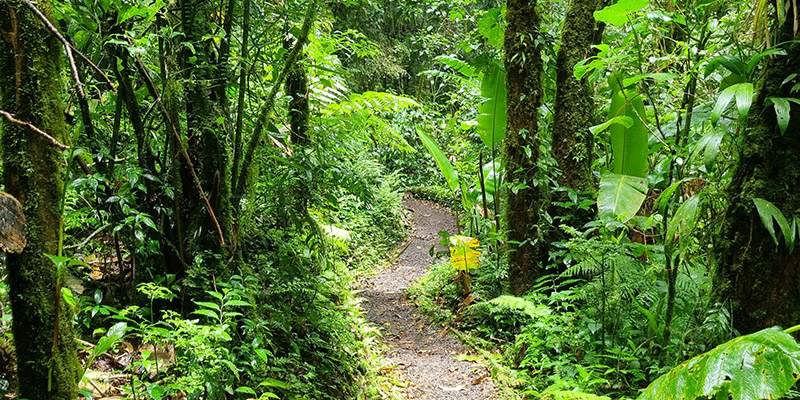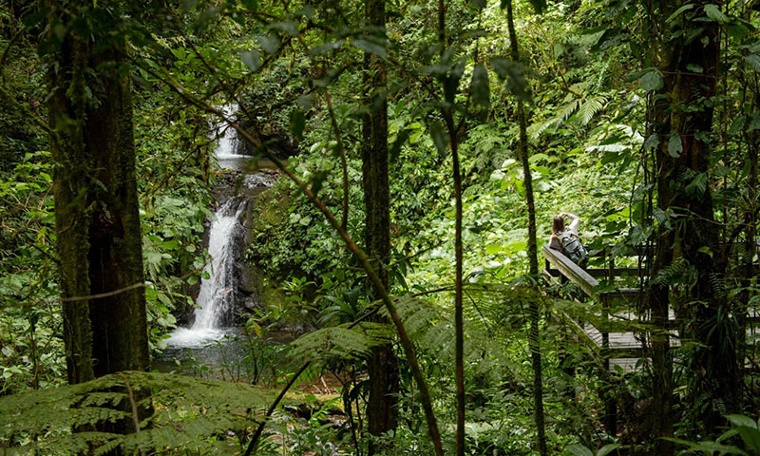What Is A Cloud Forest? And How's It Different from the Rainforest?

Life in Monteverde revolves, in many ways, around the nearby cloud forest. Why? Because it’s such a rare occurrence! Only 1% of the world's remaining forests are cloud forests. This focus on the cloud forest often distracts from the fact that we have several other kinds of forest here as well.
That’s because as you reach higher elevations, the microclimate within the forest changes, controlling the types of plants and animals that can survive within it. In general, temperatures fall by about 0.5 °C (0.9 °F) for every 100 metres (328 feet) of elevation.
Let’s start by defining the different classifications of forest that you can find within Costa Rica.
Classifications of Costa Rican Forests
Tropical Rainforest
Definition:
1: a tropical woodland with an annual rainfall of at least 100 inches (254 centimetres) and marked by lofty broad-leaved evergreen trees forming a continuous canopy. — called also tropical rainforest. 2: temperate rainforest.
Tropical Dry Forest
Definition:
Tropical dry forest describes the biome of any open woodland in tropical areas that have a long dry season which is followed by a season of heavy rainfall. Tropical dry forests are found to the north and south of tropical rainforests. They are categorized by a dry season that lasts six or more months of the year.
Tropical Cloud Forest
Definition:
A wet tropical mountain forest at an altitude usually between 3000 and 8000 feet (1000 and 2500 meters) that is characterized by a profusion of epiphytes and the presence of clouds even in the dry season
Tropical Lowland Forest
Definition:
Tropical lowland forest occurs in the humid tropics, within 10° of the equator, where rainfall is abundant throughout most of the year. They typically exist in elevation ranges from sea level-1700 m.
Riparian Forest
Definition:
A forested or wooded area of land adjacent to a body of water such as a river, pond, stream, lake, marshland, canal, sink, estuary, or reservoir.
Mangrove Swamp
Definition:
1: a group of trees or shrubs that grow in chiefly tropical coastal areas that are flooded at high tide. Mangroves typically have numerous tangled roots above ground and form dense thickets.
2: a tidal swamp that is dominated by mangroves and associated vegetation.
Transitional Forest
While not technically a classification of rainforest, you will also hear the term transitional forest on many tours, so I wanted to include it in this list. This is a term that is used to describe a forest that is experiencing growth. In other words, a forest which was diminishing in size, due to reasons like over forestation, fire, or disease, but has now recuperated to a point at which it is expanding. In Monteverde and the area around it, there are many reforestation projects underway, and so many of these forests are considered “transitional”.
Differences in Flora
For the purposes of this article, we are going to focus on the differences between cloud forests and rainforests. As I’m sure you can tell from their names, both types experience more than average levels of moisture and humidity, and that makes for some interesting types of plants.
Rainforest Vegetation
Tropical temperatures and lots of rainfall make for ideal growing conditions for many species of trees, and because of that rainforests are known for their canopy. The Oxford dictionary defines a canopy thus:
the uppermost trees or branches of the trees in a forest, forming a more or less continuous layer of foliage.
Walking into a rainforest is like stepping into a new world. The canopy above blocks out much of the brightness and heat of the tropical sun, creating a space full of dappled sunlight and dampness. There is plenty to eat, and the huge trees provide an ecosystem which sustains life in innumerable forms. In fact, more than half of the world’s species of animals and plants are found in rainforests.
As you move upwards in elevation, some species can no longer survive the cooler temperatures, but the rainforest is teeming with all sorts of life.
You will notice, as you explore that many of the tree roots are partially exposed or close to the surface, unlike the deciduous forests of North America. That’s because the soil itself is often of poor quality. Where other forests find their nutrients deep in the soil, in the rainforest- these nutrients are found above ground in the form of naturally occurring mulch made up of decomposing leaves and animals.
Cloud Forest Vegetation
Once you move upwards, away from the heat of the rainforest and into the everpresent mists of the cloud forest, everything changes.
In their search for sunlight, trees become gnarled and twisted, providing ideal surfaces for the growth of moss and epiphytes. An epiphyte is a type of plant which doesn’t grow roots into the ground but instead leaves by attaching itself to other plants and trees. Perhaps the most well-known examples are air plants and orchids.
In the dim dampness of the cloud forest, one tree can provide support for half a dozen or more other plants, and these- in turn- provide food for the local insects and creatures. The air here smells of moss and decay, but it’s not unpleasant. It’s rich and warm and green.
All around you, there are vines hanging down, leaves sprouting from every nook, and colourful flowers- mostly varieties of orchids- stretching along the length of long straight stems.
The ground underfoot is damp earth and patches of moss covered with intertwining tree roots, under which small animals live.
Differences in Fauna
Rainforest Creatures
This variety of plant life provides habitats for all sorts of interesting creatures. Everything from ant colonies that build huge ant hills and tunnels that will spread up to a kilometer in circumference, to 850 different species of birds, to apex predators like howler monkeys and jaguars can be found hidden away under the trees, and each plays an important part in the survival of the ecosystem.
Life under the canopy is extremely symbiotic, and the smallest most insignificant seeming creature could very well support large portions of the process, these are known as keystone species. Spider monkeys are a good example, these tiny but adorable creatures have an extremely large territory because they exist mainly on ripe fruit.
They have to travel large distances to find enough, and while they are doing this, they inadvertently disperse up to 150 different types of seeds, which then take root and grow. This is essential to the continued well-being of our forests- and since many of these seeds grow into hardwood trees that store carbon emissions- it’s also essential to the well-being of the planet. Click here to find out more, and to learn how you can help the spider monkey population continue to thrive.
Cloud Forest Creatures
Both rainforests and cloud forests are famous for their diversity, so many of the same animals can be found in both, with the exception perhaps, of animals which require warmer temperatures, like some species of lizard. These cold-blooded creatures like to sun themselves during the day, and the sun is difficult to find when you’re immersed in cloud cover.
Still, the forests contain over 29 species of lizards, 71 types of snakes, and 60 kinds of amphibians as well as 100 species of mammals, and that doesn’t even count the insects. The forests are teeming with life, but to explore them fully, you really need to visit in the daytime and at night. Learn more about the nightlife in our Escondido Reserve: From Night to Day post.
Jaguars are a keystone species in the Monteverde Cloud Forest. Apex predators that hunt on land and in the water, they regulate the population level of certain prey species. Without jaguars, the population of up to 87 species could increase, upsetting the delicate balance of the ecosystem.
The Forests of Monteverde
A forest is a wonderful place. It reminds us that we are not alone and that our world is created of many creatures, big and small, that must all work together to survive, and thrive. When we spend time under the trees, we forget about our phones and social media. We live in the moment, and we enjoy the sights and sounds and smells all around us, we find the kind of calm and serenity that can only be found deep in the woods, under the canopy.
There are so many wonderful places in Monteverde where you can experience the forest for yourself, and whether you explore the rainforest, or the cloud forest, or everything in between, you’re sure to leave with a much greater appreciation of the amazing place in which we live.
Here are some useful links to help you find your forest adventure.
Reserva Bosque Nuboso, Santa Elena
Monteverde Cloud Forest Reserve
For more information about The amazing variety of mammals in the forests of Monteverde- check out our Guide to the Mammals of Monteverde!





